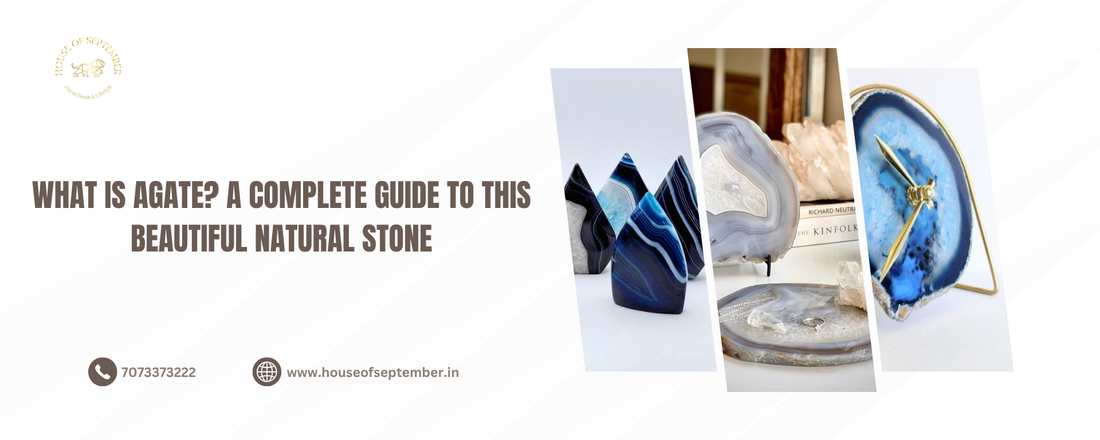
What Is Agate? A Complete Guide to This Beautiful Natural Stone
Share
What Is Agate?
Agate is a beautifully banded variety of chalcedony, a mineral in the quartz family, known for its unique patterns and vibrant colors. But it’s more than just a pretty gemstone; it’s a fascinating piece of Earth’s natural artistry that has captured human imagination for thousands of years.
What sets agate apart from other stones is its distinct layering. If you’ve ever held a polished agate slice in your hand, you’ve probably noticed its mesmerizing rings or waves of color. These patterns aren’t just for looks, they’re the result of nature taking its time, layer by layer, over millions of years.
Agate is often considered a grounding stone. In various cultures and spiritual traditions, it's believed to bring balance, protection, and emotional strength. Even if you're not into the metaphysical side of things, there's no denying the calming, earthy presence agate carries, whether it's in the form of jewelry, a showpiece, or even a simple stone on your desk.
Found all around the world, from Brazil and India to Madagascar and the U.S., agate is incredibly diverse. No two pieces are ever the same, which makes owning one feel like owning a one-of-a-kind artwork created by the planet itself.
In essence, agate is a stone that tells a story. It speaks of patience, transformation, and beauty in slow creation. Whether you’re drawn to it for its visual charm or its symbolic meaning, agate is a gem that adds both elegance and depth to your life.
History and Origin of Agate Stones
Agate has a history that goes back thousands of years, long before the days of modern crystal shops and gemstone jewelry. Its roots are deeply woven into the fabric of ancient civilizations worldwide.
The name "agate" is believed to have come from the Achates River (now known as the Dirillo River) in Sicily, where the stone was first documented by Greek philosopher Theophrastus around 300 BC. But agate was being used even earlier than that. Archaeologists have discovered agate beads and amulets in ancient Mesopotamia and Egypt, dating back to as early as 2000 BC.
So, what made agate so special to these early cultures?
For starters, it wasn’t just about looks (though its colorful bands caught attention). Agate was believed to have protective and healing powers. The Greeks and Romans wore it as amulets to guard against storms or bad luck. In the Middle East, it was considered a stone of strength and protection in battle. And in medieval times, it was used in farming rituals, believed to bring rain and ensure a good harvest.
What’s truly fascinating is how agate has transcended both time and geography. From ancient temples to royal treasures to modern-day decor, it continues to be valued for its beauty, symbolism, and natural charm.
In short, agate isn’t just a stone; it’s a piece of human history.
How Agate Is Formed
Now that we know agate’s rich history, let’s dig a little into how this mesmerizing stone actually comes to life, because it’s a story that unfolds over millions of years.
Agate forms in the hollow cavities of volcanic rocks, also known as vesicles. These empty pockets are created by gas bubbles in molten lava. Over time, silica-rich groundwater seeps into these voids. As this water evaporates, it leaves behind tiny crystals of quartz, layer after layer.
What makes agate so unique is the rhythmic layering that happens during this process. These layers can vary in color depending on the presence of different minerals, like iron, manganese, or chromium, which create the beautiful bands and swirls we see in finished agate pieces.
This slow, patient formation process can result in a wide variety of colors and patterns, some soft and subtle, others bold and vivid. That’s why no two agate stones look exactly alike. It's like Earth’s version of painting, only with minerals and time instead of brushes and paint.
Sometimes, agate is found with clear centers, tiny druzy crystals, or moss-like inclusions, all adding to its mystical charm.
In the end, agate isn’t something that’s made quickly. It’s a stone that reminds us of nature’s incredible patience, beauty, and craftsmanship. And when you hold a piece of agate in your hand, you’re quite literally holding millions of years of natural history.
Types and Colors of Agate
One of the most fascinating things about agate is how incredibly diverse it is. No two agate stones look the same, and that’s part of the charm! Thanks to the way it's formed, layer by layer over time, each piece has its character, color palette, and story.
Agate comes in a wide range of natural colors like white, grey, brown, green, pink, purple, and even soft shades of blue. Many stones are dyed to create more vivid colors (which is common in jewelry and decor), but natural agates tend to have an earthy, grounded beauty.
Here are some popular types of agate you might come across:
-Blue Lace Agate: Known for its soft, flowing bands of blue and white. It’s often associated with calmness and communication.
-Moss Agate: Looks like there are tiny pieces of moss or greenery inside the stone. It’s not moss, but mineral inclusions that create a natural landscape effect.
-Fire Agate: This one lives up to its name; it flashes with iridescent reds, oranges, and golds when it catches the light, resembling fire.
-Botswana Agate: A beautifully banded agate with neutral tones like grey, brown, and soft pink. It’s elegant and understated.
-Crazy Lace Agate: Full of swirling, fun patterns in cream, red, and gold tones. It’s often called the “Laughter Stone” for its bright, happy energy.
Each type of agate carries a slightly different vibe or “personality,” which makes it such a beloved stone for collectors, designers, and crystal enthusiasts alike.
Popular Uses of Agate
Agate isn't just admired for its beauty - it's also incredibly versatile. Over the centuries, it’s found a place in everything from ancient artifacts to modern homes. Here’s how people commonly use agate today:
1. Jewelry
Agate is a favorite in the world of jewelry, and it’s easy to see why. Whether it’s carved into beads, pendants, or statement rings, agate adds a touch of earthy elegance. Plus, it’s a durable stone, making it perfect for daily wear.
2. Home Décor
Agate has made its way into modern interiors in a big way. You’ll find it used in:
-Coasters
-Tabletops
-Bookends
-Wall art
-Candle holders
Its natural beauty and grounding colors make it a stunning (and functional) piece of decor. A polished slice of agate on a coffee table can elevate the entire room.
3. Spiritual and Wellness Practices
For those who work with healing crystals or are into metaphysical energy, agate is considered a grounding stone. It's thought to promote:
-Emotional balance
-Mental clarity
-Protection from negative energy
People often carry agate stones, meditate with them, or place them in their space to create a sense of calm and stability.
4. Gift Items
Agate is also a wonderful gifting option. From personalized keychains and decorative trays to luxury hampers featuring agate elements, it’s a unique and meaningful gift, especially for housewarmings, birthdays, or spiritual occasions.
Conclusion
Agate is more than just a beautiful stone; it's a blend of natural art, ancient history, and modern versatility. From its vibrant patterns and healing associations to its role in stylish decor and jewelry, agate proves that nature is the best designer of all.
Whether you're drawn to its calming energy, its one-of-a-kind patterns, or simply the way it looks in your home, agate has something to offer everyone. It’s a reminder that beauty can come from patience, and that even stones can tell stories, layer by layer.
So next time you see a piece of agate, take a moment to appreciate it not just as a gemstone, but as a tiny, powerful work of art created by the Earth itself.

